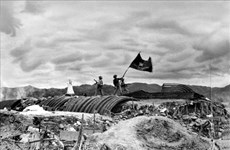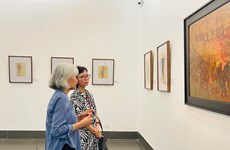King Le Du Tong reburied in homeland
A special ceremony was held to rebury
the remains of King Le Du Tong (1679-1731) in Bai Trach village, Tho
Xuan district, Thanh Hoa province on Jan. 25.
A special ceremony was held to rebury
the remains of King Le Du Tong (1679-1731) in Bai Trach village, Tho
Xuan district, Thanh Hoa province on Jan. 25.
The King’s stele will be placed at the imperial temple of the former Le Kings, alongside those of all 27 Le Kings of the former Le dynasty (1418-1789) in Dong Ve ward of Thanh Hoa city.
A 700 kg coffin of the same dimensions and design along with royal dress in replicating the originals have been prepared for the burial
King Le Du Tong was given his name Le Duy Duong by his father. He was the 22nd king of the Le dynasty, ruling from 1705 to 1729. The Le dynasty, which lasted from 1428 to 1789, is famous for its founder, King Le Loi, who liberated the country from Chinese Ming invaders.
When King Le Du Tong came to the throne, he reduced and eliminated a number of taxes.
At the time of his reign, the power of the Le dynasty was beginning to decline. The Trinh Lords (1545-1787) held the real power over the court and the country. Lord Trinh Cuong (1709-1729) ruled at the same time as King Le Du Tong.
The country was peaceful at this time, according to ancient documents, such as the Kham Dinh Viet Su Thong Giam Cuong Muc (a history book with many chapters about Viet Nam, compiled by Nguyen dynasty historians).
"The Le dynasty did many things for the country and laws were strictly implemented. The King did not have to work hard, but his domain was orderly, thanks to important contributions made by Lord Trinh Cuong," according to the text.
In 1729, the King abdicated the throne to his son Le Duy Phuong. Two years later, Le Du Tong died at the age of 52. For the last two years of his life, he was a devout Buddhist.
The king’s remains were found in February of 1958 by farmers in Bai Trach hamlet of Ban Thach Village in Tho Xuan District, in the central province of Thanh Hoa while they were digging in a field. The outer coffin was discovered first and when they broke a corner they saw a red lacquer inner coffin trimmed with gold.
After hearing the news, relevant Government officials came and used cement to mend the broken corner and then assigned local authorities to manage the tomb.
However, the local authorities were worried that the tomb presented too attractive a target for thieves.
So, with permission from the then Prime Minister Pham Van Dong and the Ministry of Culture and Information, experts from the Viet Nam History Museum and Thanh Hoa Province’s Department of Culture and Information excavated the tomb in 1964. They brought the coffin, which is made of precious ngoc am wood (also known as po mu), to the Viet Nam History Museum.
On April 2, 1964, museum scientists opened the coffin. PM Dong was in attendance.
The coffin had two bottoms, with a 10 cm layer of roasted rice between them. The body was wrapped in many layers of clothing and shrouds, including eight large shrouds made of brocade, measuring 1.5m by 5m each; a small shroud made of two layers of brocade; a large royal robe with an embroidered dragon on the front and many other smaller dragons on the back and on both sleeves; two inner royal mantles; and three pairs of silk trousers.
The King’s face was covered with a towel that has an image of a dragon in the centre.
These were the first specimens of clothing the museum ever discovered from the Le dynasty.
Also found in the coffin were a book, a pen, a brush, a paper fan, and a bag to hold betel and areca nuts.
When the towel was lifted off the King’s face, excavators were surprised to see the face was grey, and that the body was soft and the joints could move. The corpse has been preserved in a cold room at the museum since.
After several requests by the council of the Le royal family, the Ministry of Culture, Sports and Tourism permitted transport of the remains to the King’s homeland for reburial. The Prime Minister signed off on the approval on Oct. 29, 2009./.
The King’s stele will be placed at the imperial temple of the former Le Kings, alongside those of all 27 Le Kings of the former Le dynasty (1418-1789) in Dong Ve ward of Thanh Hoa city.
A 700 kg coffin of the same dimensions and design along with royal dress in replicating the originals have been prepared for the burial
King Le Du Tong was given his name Le Duy Duong by his father. He was the 22nd king of the Le dynasty, ruling from 1705 to 1729. The Le dynasty, which lasted from 1428 to 1789, is famous for its founder, King Le Loi, who liberated the country from Chinese Ming invaders.
When King Le Du Tong came to the throne, he reduced and eliminated a number of taxes.
At the time of his reign, the power of the Le dynasty was beginning to decline. The Trinh Lords (1545-1787) held the real power over the court and the country. Lord Trinh Cuong (1709-1729) ruled at the same time as King Le Du Tong.
The country was peaceful at this time, according to ancient documents, such as the Kham Dinh Viet Su Thong Giam Cuong Muc (a history book with many chapters about Viet Nam, compiled by Nguyen dynasty historians).
"The Le dynasty did many things for the country and laws were strictly implemented. The King did not have to work hard, but his domain was orderly, thanks to important contributions made by Lord Trinh Cuong," according to the text.
In 1729, the King abdicated the throne to his son Le Duy Phuong. Two years later, Le Du Tong died at the age of 52. For the last two years of his life, he was a devout Buddhist.
The king’s remains were found in February of 1958 by farmers in Bai Trach hamlet of Ban Thach Village in Tho Xuan District, in the central province of Thanh Hoa while they were digging in a field. The outer coffin was discovered first and when they broke a corner they saw a red lacquer inner coffin trimmed with gold.
After hearing the news, relevant Government officials came and used cement to mend the broken corner and then assigned local authorities to manage the tomb.
However, the local authorities were worried that the tomb presented too attractive a target for thieves.
So, with permission from the then Prime Minister Pham Van Dong and the Ministry of Culture and Information, experts from the Viet Nam History Museum and Thanh Hoa Province’s Department of Culture and Information excavated the tomb in 1964. They brought the coffin, which is made of precious ngoc am wood (also known as po mu), to the Viet Nam History Museum.
On April 2, 1964, museum scientists opened the coffin. PM Dong was in attendance.
The coffin had two bottoms, with a 10 cm layer of roasted rice between them. The body was wrapped in many layers of clothing and shrouds, including eight large shrouds made of brocade, measuring 1.5m by 5m each; a small shroud made of two layers of brocade; a large royal robe with an embroidered dragon on the front and many other smaller dragons on the back and on both sleeves; two inner royal mantles; and three pairs of silk trousers.
The King’s face was covered with a towel that has an image of a dragon in the centre.
These were the first specimens of clothing the museum ever discovered from the Le dynasty.
Also found in the coffin were a book, a pen, a brush, a paper fan, and a bag to hold betel and areca nuts.
When the towel was lifted off the King’s face, excavators were surprised to see the face was grey, and that the body was soft and the joints could move. The corpse has been preserved in a cold room at the museum since.
After several requests by the council of the Le royal family, the Ministry of Culture, Sports and Tourism permitted transport of the remains to the King’s homeland for reburial. The Prime Minister signed off on the approval on Oct. 29, 2009./.













